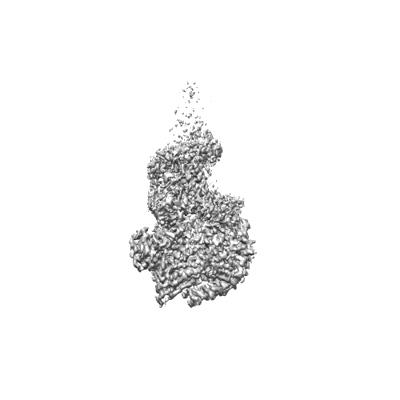EMD-24825
Ex4-D-Ala bound to the glucagon-like peptide-1 receptor/g protein complex (conformer 2)
EMD-24825
Single-particle2.51 Å
 Deposition: 07/09/2021
Deposition: 07/09/2021Map released: 05/01/2022
Last modified: 23/10/2024
Sample Organism:
Homo sapiens
Sample: GLP-1R bound to Ex4-D-Ala, G alpha s, G beta-1, G gamma-2, and Nb35
Fitted models: 7s3i (Avg. Q-score: 0.58)
Deposition Authors: Belousoff MJ ,
Piper SJ
,
Piper SJ 
Sample: GLP-1R bound to Ex4-D-Ala, G alpha s, G beta-1, G gamma-2, and Nb35
Fitted models: 7s3i (Avg. Q-score: 0.58)
Deposition Authors: Belousoff MJ
 ,
Piper SJ
,
Piper SJ 
Structural and functional diversity among agonist-bound states of the GLP-1 receptor.
Cary BP  ,
Deganutti G
,
Deganutti G  ,
Zhao P,
Truong TT,
Piper SJ
,
Zhao P,
Truong TT,
Piper SJ  ,
Liu X
,
Liu X  ,
Belousoff MJ
,
Belousoff MJ  ,
Danev R
,
Danev R  ,
Sexton PM
,
Sexton PM  ,
Wootten D
,
Wootten D  ,
Gellman SH
,
Gellman SH 
(2022) Nat Chem Biol , 18 , 256 - 263
 ,
Deganutti G
,
Deganutti G  ,
Zhao P,
Truong TT,
Piper SJ
,
Zhao P,
Truong TT,
Piper SJ  ,
Liu X
,
Liu X  ,
Belousoff MJ
,
Belousoff MJ  ,
Danev R
,
Danev R  ,
Sexton PM
,
Sexton PM  ,
Wootten D
,
Wootten D  ,
Gellman SH
,
Gellman SH 
(2022) Nat Chem Biol , 18 , 256 - 263
Abstract:
Recent advances in G-protein-coupled receptor (GPCR) structural elucidation have strengthened previous hypotheses that multidimensional signal propagation mediated by these receptors depends, in part, on their conformational mobility; however, the relationship between receptor function and static structures is inherently uncertain. Here, we examine the contribution of peptide agonist conformational plasticity to activation of the glucagon-like peptide 1 receptor (GLP-1R), an important clinical target. We use variants of the peptides GLP-1 and exendin-4 (Ex4) to explore the interplay between helical propensity near the agonist N terminus and the ability to bind to and activate the receptor. Cryo-EM analysis of a complex involving an Ex4 analog, the GLP-1R and Gs heterotrimer revealed two receptor conformers with distinct modes of peptide-receptor engagement. Our functional and structural data, along with molecular dynamics (MD) simulations, suggest that receptor conformational dynamics associated with flexibility of the peptide N-terminal activation domain may be a key determinant of agonist efficacy.
Recent advances in G-protein-coupled receptor (GPCR) structural elucidation have strengthened previous hypotheses that multidimensional signal propagation mediated by these receptors depends, in part, on their conformational mobility; however, the relationship between receptor function and static structures is inherently uncertain. Here, we examine the contribution of peptide agonist conformational plasticity to activation of the glucagon-like peptide 1 receptor (GLP-1R), an important clinical target. We use variants of the peptides GLP-1 and exendin-4 (Ex4) to explore the interplay between helical propensity near the agonist N terminus and the ability to bind to and activate the receptor. Cryo-EM analysis of a complex involving an Ex4 analog, the GLP-1R and Gs heterotrimer revealed two receptor conformers with distinct modes of peptide-receptor engagement. Our functional and structural data, along with molecular dynamics (MD) simulations, suggest that receptor conformational dynamics associated with flexibility of the peptide N-terminal activation domain may be a key determinant of agonist efficacy.
